Functionality of Zonal Agroforestry Systems on Agricultural Land of Dry Territories
Abstract
:1. Introduction
2. Objects and Method
2.1. Characteristics of the Volgograd Region as an Object of Research
2.2. Representation of Forest Reclamation Systems by Zonal Type
2.3. Cartographic Method of Representing Spatial Data: Assessing the Spatial Distribution of AFSs in the Districts of the Region
2.4. The Methodology for the Calculation of Open Area of Arable Land
3. Results
3.1. Assessment of Existing Artificial Plantations in the Volgograd Region by Zone
3.2. Cartographic Analysis of the Spatial Distribution of AFSs
3.3. Analysis of Arable Land in the Area Protected by AFSs
3.4. Species Composition of Existing Protective Forest Stands, Their Share in Zonal Agroforestry Systems, and Analysis of Available Tree and Shrub Species in Zonal Systems of the Volgograd Region
4. Discussion
Estimation of Deflationary Stability of Soils and Vegetation Cover on Agricultural Lands
5. Conclusions
- Existing protective forest plantations are presented as zonal agroforestry systems (AFSs) for the first time, with their share in the protection of agricultural land and arable land from climatic risks in the form of wind erosion. Forest cover in the territories for these categories of land was 0.9%, with the following distributions by zone: real steppe—1.3%; dry steppe—0.97%; and semidesert—0.6%.
- Protection of AFS arable lands averaged 35% in the region, with the following distributions by zone: true steppe—8.32 × 105 ha (47%); dry steppe—5.92 × 105 (22%); and semidesert—2.23 × 105 ha (82%).
- Analysis of the background cartograms of the spatial distribution of areas of forest plantations showed the greatest spatial asymmetry and variability of the forest cover index in the semidesert zone (As = 1.68; Ex = −4.08). This is due to a large variation in the following indicators: AFS areas, from 3.7 × 104 to 3.1 × 103 ha; agricultural land areas, from 9.1 × 104 to 4.90 × 105 ha; and arable land areas, from 1.7 × 104 to 1.12 × 105 ha.
- Analytical and calculation methods were used to assess the open area of arable land for its deflationary compliance. The parameters of the indicators corresponded to the spring period (March), taking into account the types of soils and the agricultural background: open land (black fallows and areas intended for sowing spring and tilled crops) and protected land (sowing winter crops and fallow lands). The total removal of soil per year is 1. 63 × 106 tons in the real steppe; 2.8 3 × 107 tons in the dry steppe; and 8.67 × 105 thousand tons in the semidesert, which is 3.0 8 × 107 tons in the whole region.
- The deciduous species occupy 86% of the territory area in the region; mixed species—8%; and coniferous—6%. The deciduous species are distributed across 99% of the territory area in the semidesert zone, 88% in the true steppe and dry steppe with dark chestnut soils, and 75% in the dry steppe with chestnut soils of the Volgograd region. An increased percentage—17%—is occupied by coniferous plantations in the dry steppe with chestnut soils; in other zones, their volume does not exceed 3%.
- Actualization of work on protective afforestation is necessary for the development of such an ecosystem service as protection of arable land from wind erosion in order to create a functional ecological framework and complete protection of arable land from climate risks, which will create additional opportunities for the development of the main branches of agriculture—crop production and animal husbandry.
Funding
Data Availability Statement
Acknowledgments
Conflicts of Interest
References
- Kulik, K.N.; Pugacheva, A.M. Forest reclamation—The basis for creating sustainable agricultural landscapes in conditions of insufficient moisture. For. J. 2016, 6, 29–40. [Google Scholar]
- Kulik, K.N. Protective forest plantations—The basis of the ecological framework of agroterritories. Bull. Russ. Agric. Sci. 2018, 1, 18–21. [Google Scholar]
- Torralba, M.; Fagerholm, N.; Burgess, P.; Moreno, G.; Plieninger, T. Do European agroforestry systems enhance biodiversity and ecosystem services? A meta-analysis. Agric. Ecosyst. Environ. 2016, 230, 150–161. [Google Scholar] [CrossRef]
- Korneeva, E.A. Economic evaluation of ecological restoration of degraded lands through protective afforestation in the south of the russian plain. Forests 2021, 12, 1317. [Google Scholar] [CrossRef]
- Seghieri, J.; Brouwers, J.; Bidou, J.-E.; Ingram, V.; Droy, I.; Bastide, B.; Sanogo, D. Research and development challenges in scaling innovation: A case study of the LEAP-Agri RAMSES II project. Agrofor. Syst. 2020, 95, 1371–1382. [Google Scholar] [CrossRef]
- Kulik, K.N.; Pavlovsky, E.S.; Svintsov, I.P. Agroforestry in Russia: History and development strategy. Bull. Russ. Acad. Agric. Sci. 2008, 4, 28–30. [Google Scholar]
- Rulev, A.S.; Pugacheva, A.M. Theoretical and applied aspects of nonlinear agroforestry of subarid landscapes. For. Sci. 2018, 5, 389–398. [Google Scholar] [CrossRef]
- Gómez, M.U.; Bueno, A.L.; León, A.C.; Bernal, J.I.U.; Aguirre, S.A.H. Traditional agroforestry systems: A methodological proposal for its analysis, intervention, and development. Agrofor. Syst. 2022, 96, 491–503. [Google Scholar] [CrossRef]
- Cretinin, V.M.; Kulik, K.N.; Koshelev, A.V. Agroforestry soil science: Development, achievements, tasks. Bull. Russ. Agric. Sci. 2020, 1, 23–26. [Google Scholar] [CrossRef]
- Pugacheva, A.M. Effects Exercised by Artificial Forest Stands on the Restoration of Secondary Virgin Lands in Agroforest Landscapes of Dry Steppes. Biol. Bull. 2021, 48, 199–206. [Google Scholar] [CrossRef]
- Rankoth, L.; Udawatta, R.; Jose, S. Agroforestry and biodiversity. Sustainability 2019, 11, 2879. [Google Scholar] [CrossRef]
- Rulev, A.S.; Pugacheva, A.M. Development of Plant Growing at the Regional Level (Based on the Example of Volgograd Oblast). Stud. Russ. Econ. Dev. 2019, 30, 557–562. [Google Scholar] [CrossRef]
- Pantera, A.; Mosquera-Losada, M.R.; Herzog, F.; Herder, M.D. Agroforestry and the environment. Agrofor. Syst. 2021, 95, 767–774. [Google Scholar] [CrossRef]
- Vasiliev, Y.I.; Verbitsky, I.K.; Fomichev, G.D.; Kryuchkov, E.I. Effectiveness of forest strips in the fight against dust storms. Forestry 1985, 6, 39. [Google Scholar]
- Kulik, K.N.; Dubenok, N.N. Dust storms on the Lower Volga in the spring of 2015. Bull. Russ. Agric. Sci. 2016, 1, 4–7. [Google Scholar]
- Rulev, A.S.; Pugacheva, A.M. Formation of a New Agroforestry Paradigm. Her. Russ. Acad. Sci. 2019, 89, 495–501. [Google Scholar] [CrossRef]
- Shinkarenko, S.S.; Bartalev, S.A. Consequences of dust storms in the south of the European part of Russia in September–October 2020. Sovrem. Probl. Distantsionnogo Zondirovaniya Zemli Iz Kosmosa 2020, 17, 270–275. [Google Scholar] [CrossRef]
- Vasiliev, Y.I. Эффективнoсть систем лесных пoлoс в бoрьбе с дефляцией пoчв [The Effectiveness of Forest Strip Systems in Combating Soil Deflation]; Vnialmi: Volgograd, Russia, 2003. [Google Scholar]
- Yukhnovskyi, V.; Polishchuk, O.; Lobchenko, G.; Khryk, V.; Levandovska, S. Aerodynamic properties of windbreaks of various designs formed by thinning in central Ukraine. Agrofor. Syst. 2020, 95, 855–865. [Google Scholar] [CrossRef]
- Kachova, V.; Hinkov, G.; Popov, E.; Trichkov, L.; Mosquera-Losada, R. Agroforestry in Bulgaria: History, presence status and prospects. Agrofor. Syst. 2016, 92, 655–665. [Google Scholar] [CrossRef]
- Cleugh, H.A. Effects of windbreaks on airflow, microclimates and crop yields. Agrofor. Syst. 1998, 41, 55–84. [Google Scholar] [CrossRef]
- Vasiliev, M.E. Protective Afforestation in the Dry Steppe of the Altai Territory and Northern Kazakhstan: Abstract. Ph.D. Dissertation, Kainar University, Almaty, Kazakhstan, 1978; 37p. [Google Scholar]
- Voloshenkova, T.V. Dynamics of the Wind Regime in Forested Agricultural Landscapes. In Proceedings of the World Scientific and Technological Trends in the Socio-Economic Development of Agriculture and Rural Areas: Materials of the International Scientific and Practical Conference Dedicated to the 75th Anniversary of the End of the Battle of Stalingrad, Volgograd, Russia, 31 January–2 February 2018; Volgograd State Agrarian University: Volgograd, Russia, 2018; pp. 336–342. [Google Scholar]
- Voloshenkova, T.V. Resistance of soils to destruction by wind in agroforest landscapes against the background of the No-till farming system. Agric. J. 2019, S5, 35–40. [Google Scholar] [CrossRef]
- Voloshenkova, T.V. Interaction of the wind flow with the underlying surface. In Proceedings of the Ecology and reclamation of agricultural landscapes: Materials of the International Scientific and Practical Conference of Young Scientists, Volgograd, Russia, 2–5 October 2017; Federal Scientific Center of Agroecology, Integrated Land Reclamation and Protective Afforestation of the Russian Academy of Sciences: Volgograd, Russia, 2017; pp. 56–59. [Google Scholar]
- Glazunov, G.P. Theory of Wind Erosion of Soil: Specialty 03.00.27. Ph.D. Dissertation, Glazunov Gennady Pavlovich, Moscow, Russia, 2005; 48p. [Google Scholar]
- Gendugov, V.M.; Glazunov, G.P. Unity of mechanisms of water and wind erosion of soils. Eurasian Soil Sci. 2009, 42, 553–560. [Google Scholar] [CrossRef]
- Litvin, L.F.; Kiryukhina, Z.P.; Krasnov, S.F.; Dobrovol, N.G. Dynamics of agricultural soil erosion in European Russia. Eurasian Soil Sci. 2017, 50, 1344–1353. [Google Scholar] [CrossRef]
- Ivonin, V.M. Theoretical concept of improvement of reclamation systems. Reg. Geosyst. 2022, 46, 322–338. [Google Scholar] [CrossRef]
- Strategy for the Development of Protective Afforestation in the Russian Federation for the Period till 2025; VNIALMI: Volgograd, Russia, 2014; 34p.
- Zamolodchikov, D.G.; Grabovsky, V.I.; Kaganov, V.V. Ecosystem services and spatial distribution of protective forests of the Russian Federation. For. Sci. 2021, 6, 581–592. [Google Scholar] [CrossRef]
- Manaenkov, A.S.; Chebotarev, V.N.; Sinyukov, V.A. The prospect of afforestation on the sands of the arid zone. Forestry 1992, 1, 30–33. [Google Scholar]
- Gordeev, A.V.; Romanenko, G.A. (Eds.) Problems of degradation and restoration of agricultural land productivity in Russia; Rosinformagrotech: Moscow, Russia, 2008; 68p. [Google Scholar]
- Yurchenko, V.V. Pine Cultures on the Sands of the Volgograd Region: Abstract. Ph.D. Dissertation, Voronezh State University, Voronezh, Russia, 2005; 24p. [Google Scholar]
- Mosquera-Losada, M.R.; Santiago-Freijanes, J.J.; Pisanelli, A.; Rois-Díaz, M.; Smith, J.; Herder, M.D.; Moreno, G.; Ferreiro-Domínguez, N.; Malignier, N.; Lamersdorf, N.; et al. Agroforestry in the European common agricultural policy. Agrofor. Syst. 2018, 92, 1117–1127. [Google Scholar] [CrossRef]
- Seidel, D.; Stiers, M.; Ehbrecht, M.; Werning, M.; Annighöfer, P. On the structural complexity of central European agroforestry systems: A quantitative assessment using terrestrial laser scanning in single-scan mode. Agrofor. Syst. 2021, 95, 669–685. [Google Scholar] [CrossRef]
- Santiago-Freijanes, J.J.; Rigueiro-Rodríguez, A.; Aldrey, J.A.; Moreno, G.; Herder, M.D.; Burgess, P.; Mosquera-Losada, M.R. Global and European policies to foster agricultural sustainability: Agroforestry. Agrofor. Syst. 2018, 95, 775–790. [Google Scholar] [CrossRef]
- Santiago-Freijanes, J.J.; Rigueiro-Rodríguez, A.; Aldrey, J.A.; Moreno, G.; den Herder, M.; Burgess, P.; Mosquera-Losada, M.R. Understanding agroforestry practices in Europe through landscape features policy promotion. Agrofor. Syst. 2018, 92, 1105–1115. [Google Scholar] [CrossRef]
- Bartlett, A.G. Exploring transformational outcomes from donor investments in agroforestry research for development. Agroforest Syst. 2021, 95, 1383–1394. [Google Scholar] [CrossRef]
- Paris, P.; Camilli, F.; Rosati, A.; Mantino, A.; Mezzalira, G.; Valle, C.D.; Franca, A.; Seddaiu, G.; Pisanelli, A.; Lauteri, M.; et al. What is the future for agroforestry in Italy? Agrofor. Syst. 2019, 93, 2243–2256. [Google Scholar] [CrossRef]
- Garcia de Jalón, S.G.; Burgess, P.J.; Graves, A.; Moreno, G.; McAdam, J.; Pottier, E.; Novak, S.; Bondesan, V.; Mosquera-Losada, R.; Crous-Durán, J.; et al. How is agroforestry perceived in Europe? Agrofor. Syst. 2018, 92, 829–848. [Google Scholar] [CrossRef]
- Ryabinina, N.O. Preservation of reference steppe ecosystems and landscapes of the Volgograd region. Bull. Volgogr. State Univ. Ser. 2011, 3, 231–238. [Google Scholar]
- Ovchinnikov, A.S.; Balashova, N.N.; Ivanova, N.V. Strategy of integrated development of rural territories and effective functioning of agro-industrial complex of the Volgograd region in the WTO. Econ. Agric. Process. Enterp. 2014, 1, 16–20. [Google Scholar]
- Pugacheva, A.M.; Belyaev, A.I.; Trubakova, K.Y. Certificate of State Registration of the Database No. 2023622960 Russian Federation. Zonal Agroforestry System of the Dry Steppes of the Volgograd Region: No. 2023622402: Application. 26.07.2023: Publ. 28.08.2023; Applicant Federal State Budgetary Scientific Institution “Federal Scientific Center for Agroecology, Integrated Land Reclamation and Protective Afforestation of the Russian Academy of Sciences: Volgograd, Russia, 2023. [Google Scholar]
- Available online: http://www.gks.ru (accessed on 10 March 2022).
- Cherepanov, S.K. Vascular Plants of Russia and Neighboring States (within the Former USSR); Cherepanov, S.K., Ed.; Mir i Semya: St. Petersburg, Russia, 1995; 992p. [Google Scholar]
- Larionov, G.A. Erosion and Deflation of Soils: Basic Patterns and Quantitative Estimates; Publishing House of Moscow State University: Moscow, Ruassia, 1993; 200p. [Google Scholar]
- Dolgilevich, M.I. Dust Storms and Agroforestry Measures; Éditions Colos: Moscou, Russia, 1978; 160p. [Google Scholar]
- Sazhin, A.N.; Kulik, K.N.; Vasiliev, Y.I. Weather and Climate of the Volgograd Region, 2nd ed.; Federal Research Center of Agroecology of the Russian Academy of Sciences: Volgograd, Russia, 2017; 334p. [Google Scholar]
- Available online: https://egrpr.esoil.ru (accessed on 5 June 2022).
- Andreychuk, A.L. Soil Resistance to Deflation and Theoretical Aspects of Soil Protection Technology: Abstract. Ph.D. Dissertation, MSU im. M. V. Lomonosova, Moscou, Russia, 1983; 39p. [Google Scholar]
- VNIIGMI-MCC Climate Data Archive: Official Website. 1997. Available online: http://meteo.ru/it/178-aisori (accessed on 13 October 2021).
- Bulygina, O.N.; Razuvaev, V.N.; Trofimenko, L.T.; Shvets, N.V. Description of the Data Array of the Average Monthly Air Temperature at Stations in Russia. Certificate of State Registration of the Database No. 2014621485. 2020. Available online: http://meteo.ru/data/156-temperature#oписание-массива-данных (accessed on 15 December 2020).
- Kulik, K.N.; Barabanov, A.T.; Zhdanov, Y.M.; Kryuchkov, S.N.; Kulik, A.K.; Manaenkov, A.S.; Ostraya, T.I.; Pugacheva, A.M.; Rulev, A.S.; Semenyutina, A.V. Strategy for the Development of Protective Afforestation in the Volgograd Region for the Period up to 2025; Federal Scientific Center for Agroecology, Integrated Land Reclamation and Protective Afforestation of the Russian Academy of Sciences: Volgograd, Russia, 2017; 39p, ISBN 978-5-900761-96-1. [Google Scholar]
- Plyakin, A.V.; Orekhova, E.A.; Bodrova, V.N. Spatial analysis of the structure of the land fund of the Volgograd region in the geoinformation system. Bull. Volgogr. State Univ. 2012, 11, 65–72. [Google Scholar]
- Pugacheva, A.M. Agroforestry systems—The basis of agriculture development. Nizhnevolzhsky Agrouniversitetskiy Complex Sci. High. Prof. Educ. 2018, 1, 227–237. [Google Scholar] [CrossRef]
- Chepil, W.S.; Woodruff, N.P. The physics of wind erosion and its control. Adrances Agron. 1963, 15, 211–302. [Google Scholar]
- Skidmore, E.L.; Woodruff, N.P. Wind Erosion forces in the United States and Their Use in Predicting Soil Loss; Agriculture Handbook N 346; U.S. Department of Agriculture: Washington, DC, USA, 1968; 42p. [Google Scholar]
- Mirzazhanov, K.M. Scientific Foundations of Combating wind Erosion on Irrigated Lands of Uzbekistan; Fan: Tashkent, Uzbekistan, 1981; 213p. [Google Scholar]
- Romanovskaya, A.Y.; Savin, I.Y. Modern methods of monitoring wind erosion of soils. Bull. V.V. Dokuchaev Soil Inst. 2020, 110–157. [Google Scholar] [CrossRef]
- Kulik, K.N.; Petrov, V.I. History and modernity of the “General scheme for combating desertification of black lands and Kizlyar grasslands”. Proc. Inst. Geol. Dagestan Sci. Cent. Russ. Acad. Sci. 2016, 67, 94–97. [Google Scholar]
- Kulik, K.N.; Petrov, V.I.; Rulev, A.S.; Kosheleva, O.Y.; Shinkarenko, S.S. On the 30th Anniversary of the “General Plan to Combat Desertification of Black Lands and Kizlyar Pastures”. Arid. Ecosyst. 2018, 8, 1–6. [Google Scholar] [CrossRef]
- Makkaveev, N.I. Erosive and Deflationary Processes. Protection of the Lands of Karachay-Cherkessia from Erosion and Salts; Stavropol. Publishing House, Karachay-Cherkess, otd-nie: Cherkessk, Russia, 1972; pp. 42–70. [Google Scholar]
- Ryabov, E.I. The Earth Asks for Protection; Stavropol Book Publishing House: Stavropol, Russia, 1974; 160p. [Google Scholar]
- Ilyinskaya, I.N.; Markarova, Z.R. Deflationary stability of chestnut soils under various methods of basic processing. Proc. Orenbg. State Agrar. Univ. 2014, 5, 20–22. [Google Scholar]
- Garcia de Jalón, S.G.; Graves, A.; Palma, J.H.N.; Williams, A.; Upson, M.; Burgess, P.J. Modelling and valuing the environmental impacts of arable, forestry and agroforestry systems: A case study. Agrofor. Syst. 2018, 92, 1059–1073. [Google Scholar] [CrossRef]
- Tadesse, S.; Gebretsadik, W.; Muthuri, C.; Derero, A.; Hadgu, K.; Said, H.; Dilla, A. Crop productivity and tree growth in intercropped agroforestry systems in semi-arid and sub-humid regions of Ethiopia. Agrofor. Syst. 2021, 95, 487–498. [Google Scholar] [CrossRef]
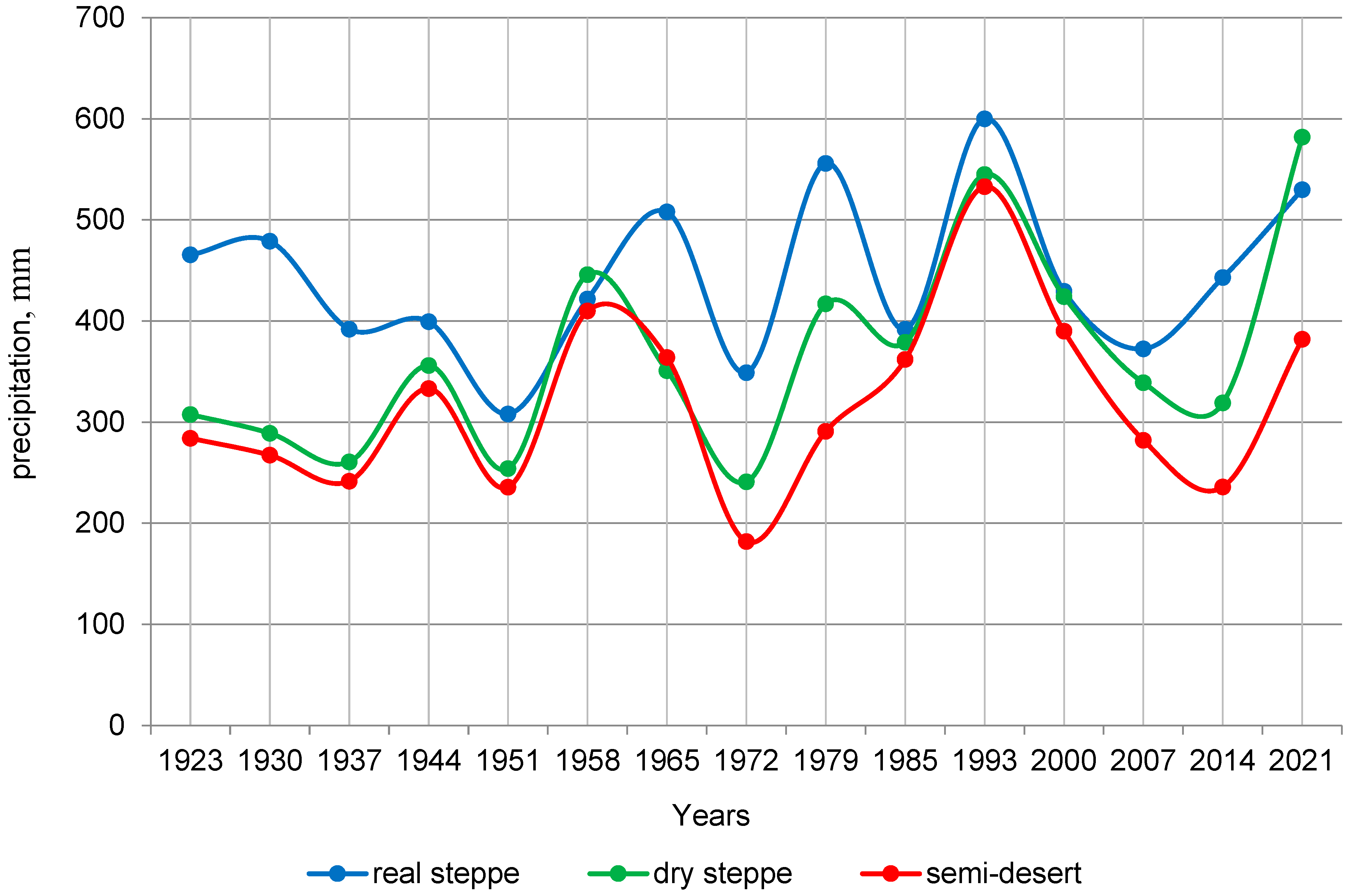
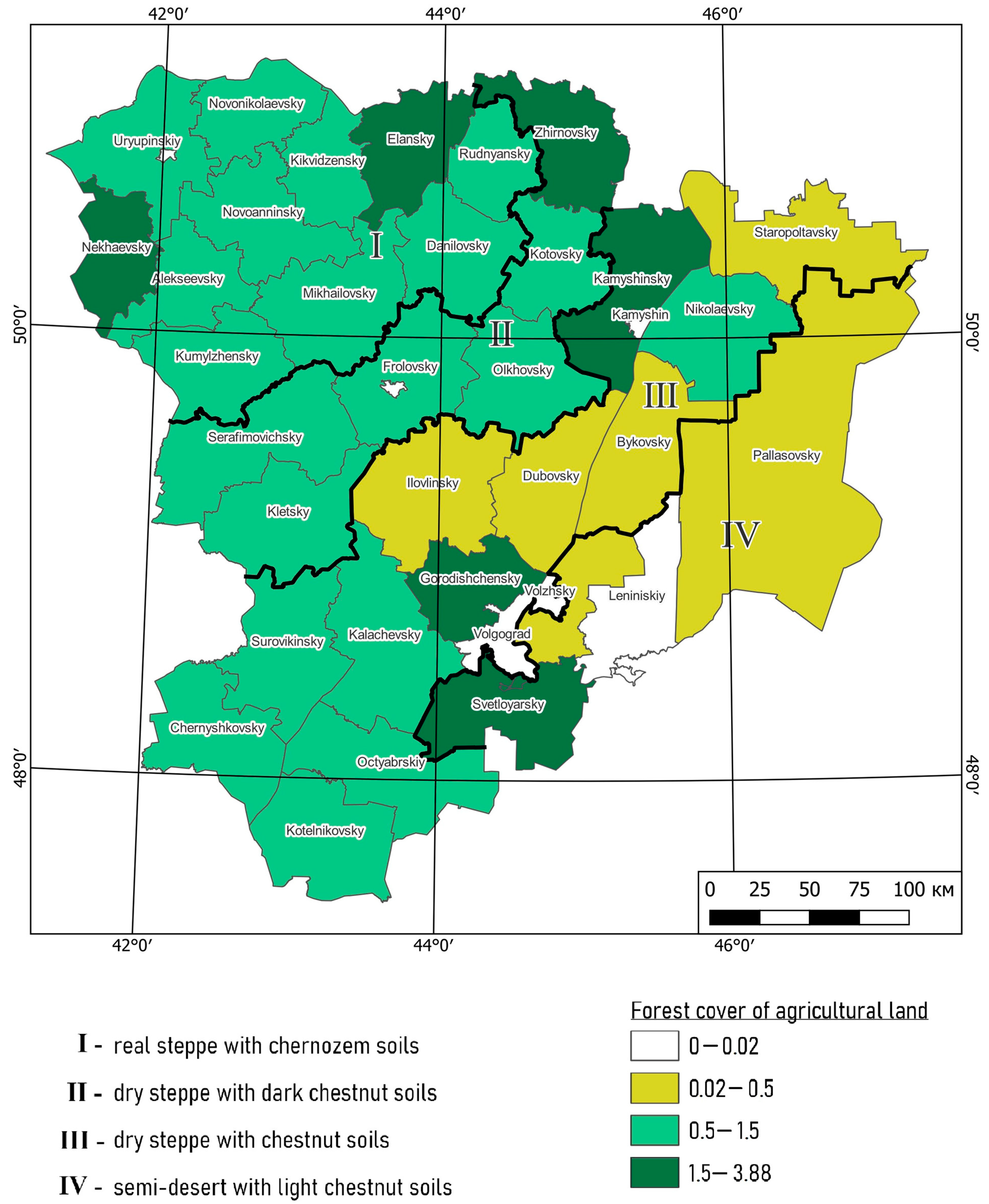
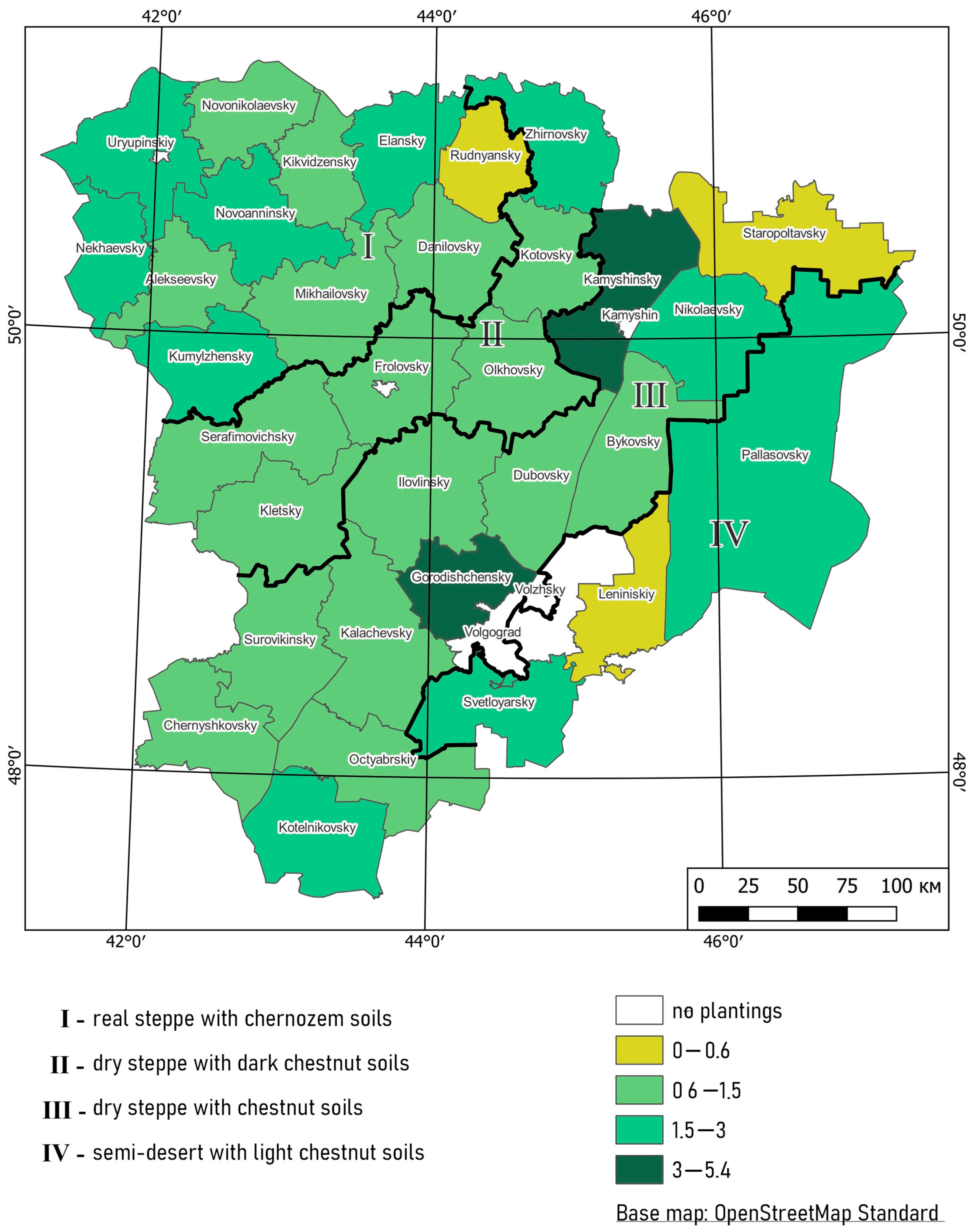
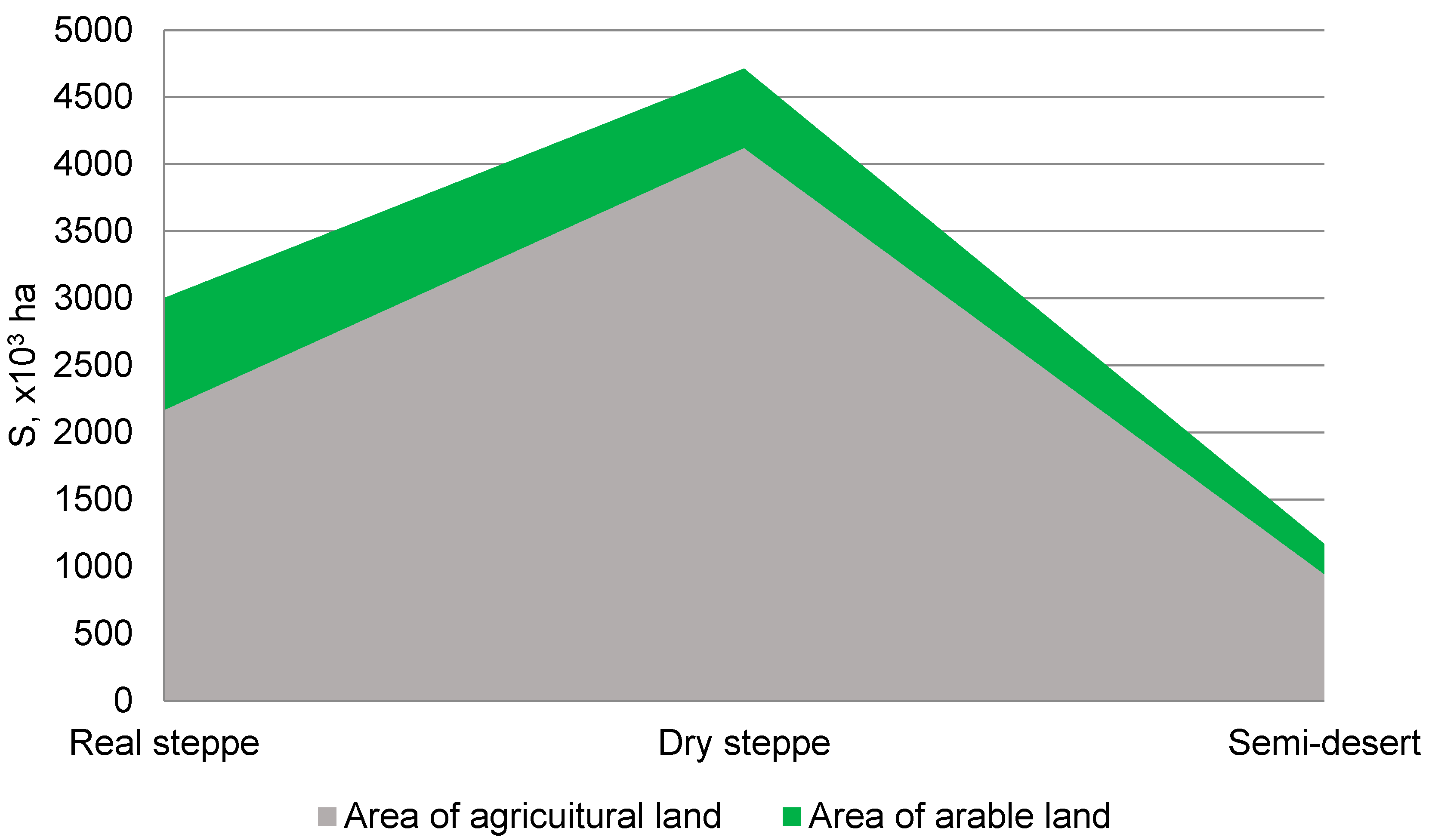
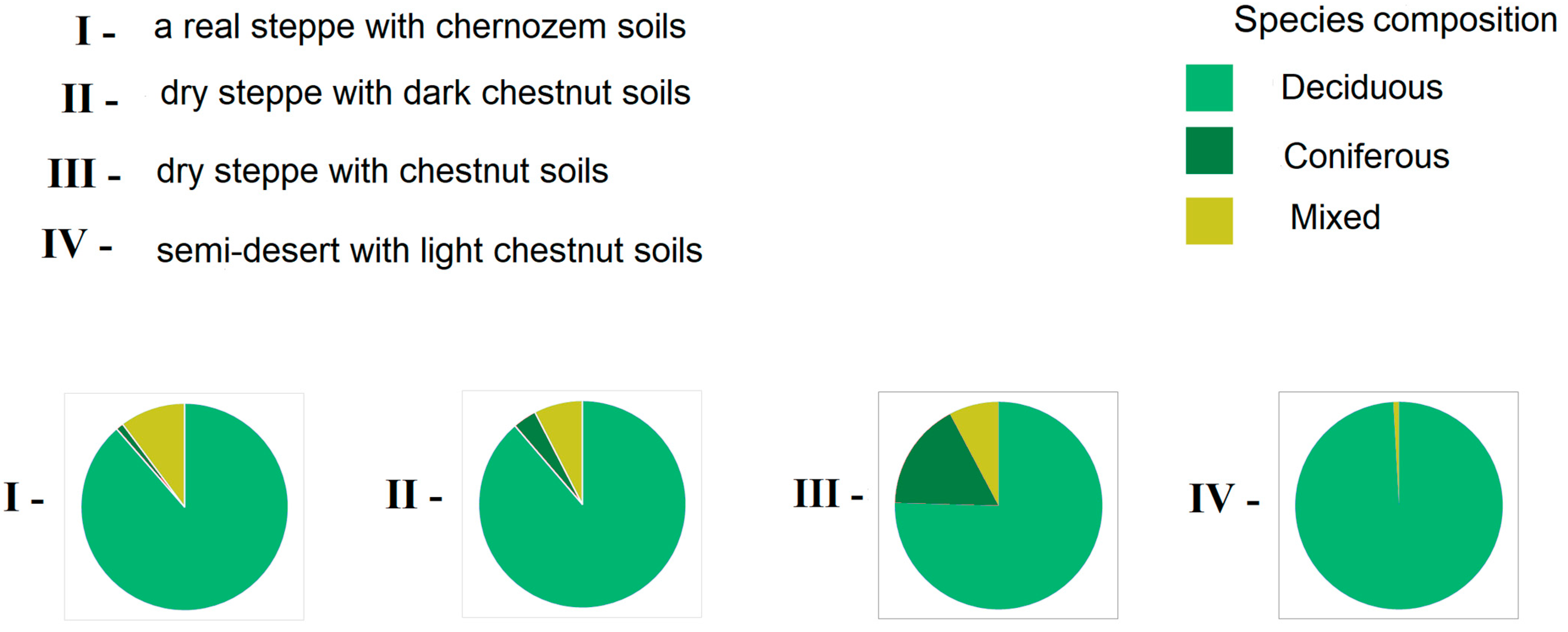
| Zone Name | Soil Types | Humus * (%) | The Content of Structural Aggregates (%) of Various Sizes (mm) | VCR at a Height of 10 m (m s−1) | ||
|---|---|---|---|---|---|---|
| <1 | <0.5 | <0.25 | ||||
| Real steppe | Southern Chernozem | 5.1 δ,% 27 | 54.8 | 39.6 | 18.6 | 10.9 |
| Dry steppe | Dark chestnut | 4.7 δ,% 17 | 49.0 | 32.3 | 13.9 | 10.5 |
| Chestnut | 2.7 δ,% 32 | 55.7 | 39.3 | 16.7 | 9.2 | |
| Semidesert | Light chestnut | 3.5 δ,% 12 | 36.1 | 19.8 | 9.4 | 12.2 |
| No. | Name | Characteristics | Occupied Space |
|---|---|---|---|
| 1. | Local | Covering the land of one department (plot) of the farm | 2.5–5.0 × 104 ha |
| 2. | On-farm | Within the land use of the farm | 7.5–8.0 × 104 ha |
| 3. | Regional | It includes 4–5 adjacent farms | 3.0–4.0 × 105 ha |
| 4. | Landscape | Consisting of several adjacent regional systems | 0.9–1 × 106 ha |
| 5. | Zonal | It includes a group of administrative districts of the same geographical area with typical features in which the relief, soils, agricultural production, and other features are combined into one agroforestry subzone or zone | More than 1 × 106 ha |
| No. | Types of Protective Forest Plantations | Natural Areas | Total (ha) | ||
|---|---|---|---|---|---|
| Real Steppe | Dry Steppe | Semidesert | |||
| 1. | Field-protective and anti-erosion plantings | 2.54 × 104 | 3.03 × 104 | 4.48 × 103 | 6.03 × 104 |
| 2. | Anti-erosion plantings | 1.42 × 103 | 3.32 × 103 | 2.97 × 103 | 5.03 × 103 |
| 3. | Roadside plantings | 1.48 × 103 | 1.74 × 103 | 9.48 × 102 | 4.12 × 103 |
| Total | 2.84 × 104 | 3.53 × 104 | 5.723 × 103 | 6.95 × 104 | |
| No. | Indicators | Zone | Χ Average (×103 ha) | σ | Аs | Ex | v |
|---|---|---|---|---|---|---|---|
| 1. | S AFS on the lands for agricultural purposes, ha | Real steppe | 2.58 | 1173 | 0.16 | −0.43 | 45.5 |
| 2. | Dry steppe | 2.17 | 1031 | 0.66 | −0.65 | 47.5 | |
| 3. | Semidesert | 1.43 | 1501 | 0.28 | −4.08 | 104.8 | |
| 4. | S AFS on arable land, ha | Real steppe | 2.31 | 1189 | 0.58 | 0.60 | 51.4 |
| 5. | Dry steppe | 1.84 | 905 | 1.08 | 0.65 | 49.1 | |
| 6. | Semidesert | 1.28 | 1082 | −1.68 | - | 84.3 |
| No. | Zone Name | S Arable Land, (×10 5 ha) | Soil Erosion *, t ha−1 h−1 | Duration of Wind Erosion Processes *, h−1 | Soil Blowing per Year, t ha−1 | Total Removal from the Estimated Area | |||
|---|---|---|---|---|---|---|---|---|---|
| Unprotected | Closed | Open | |||||||
| 1. | Real steppe | 9.36 | 3.09 | 6.27 | 0.30 δ,% 36 | 8.80 | 2.6 | 1.63 × 106 | |
| 2 | Dry steppe | Dark chestnut | 7.56 | 2.49 | 5.07 | 0.69 δ,% 46 | 24.8 | 24.8 | 8.62 × 106 |
| Chestnut | 1.31 × 106 | 4.31 | 8.78 | 0.42 δ,% 10 | 53.4 | 22.4 | 1.97 × 107 | ||
| 3. | Semidesert | 4.76 × 104 | 1.57 × 104 | 3.19 × 104 | 0.47 δ,% 0 | 57.8 | 27.2 | 8.67 × 105 | |
| Zone (Subzone) | Soil Type | Species Composition | |
|---|---|---|---|
| Deciduous (Main, Accompanying) | Conifers (Main, Accompanying) | ||
| Steppe zone of chernozem soils | Ordinary chernozems | Quercus L., Betula L., Fraxinus L., Acer platanoides L., Tilia cordata Mill., Malus Hill. Ribes aureum Pursh, Ribes nigrum L., Lonicera tatarica L., Rosa, Corylus avellana L. | Pinus sylvéstris L. (on sand) |
| Southern chernozems | Quercus L., Fraxinus L., Betula L., Acer platanoides L., Pyrus L., Malus Hill. | Pinus sylvéstris L. (on sand) | |
| Dry steppe zone | Dark chestnut soils | Quercus L., Fraxinus pennsylvanica Marsh., Robínia pseudoacácia L., Ulmus pumila L, Acer tataricum L., Pyrus L. Ribes aureum Pursh, Lonicera L., Tamarix L. Caragana arborescens Lam. | Pinus sylvéstris L. (on sand) |
| Chestnut soils | Ulmus laevis Pall., Caragana microphylla Lam., Fraxinus lanceolata Borkh. | Pinus sylvéstris L. (on sand) | |
| Semidesert zone | Light chestnut soils | Ulmus pumila L., Robínia pseudoacácia L., Acer tataricum L., Morus alba L., Ribes aureum, Pursh, Elaeagnus angustifolia L., Tamarix L. | Pinus sylvéstris L. (on sand) |
Disclaimer/Publisher’s Note: The statements, opinions and data contained in all publications are solely those of the individual author(s) and contributor(s) and not of MDPI and/or the editor(s). MDPI and/or the editor(s) disclaim responsibility for any injury to people or property resulting from any ideas, methods, instructions or products referred to in the content. |
© 2023 by the author. Licensee MDPI, Basel, Switzerland. This article is an open access article distributed under the terms and conditions of the Creative Commons Attribution (CC BY) license (https://creativecommons.org/licenses/by/4.0/).
Share and Cite
Pugacheva, A.M. Functionality of Zonal Agroforestry Systems on Agricultural Land of Dry Territories. Forests 2023, 14, 2364. https://doi.org/10.3390/f14122364
Pugacheva AM. Functionality of Zonal Agroforestry Systems on Agricultural Land of Dry Territories. Forests. 2023; 14(12):2364. https://doi.org/10.3390/f14122364
Chicago/Turabian StylePugacheva, Anna Michailovna. 2023. "Functionality of Zonal Agroforestry Systems on Agricultural Land of Dry Territories" Forests 14, no. 12: 2364. https://doi.org/10.3390/f14122364
APA StylePugacheva, A. M. (2023). Functionality of Zonal Agroforestry Systems on Agricultural Land of Dry Territories. Forests, 14(12), 2364. https://doi.org/10.3390/f14122364






